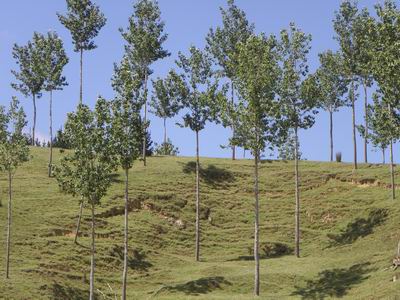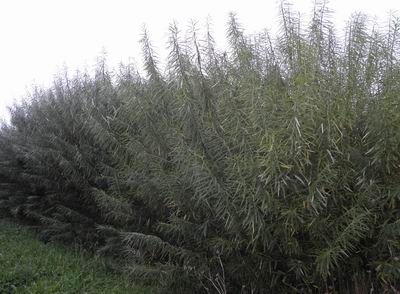Poplars and willows for soil conservation
About poplars and willows
Poplars and willows are highly versatile and valuable trees that are ideal for helping to prevent or control erosion.
Specially developed for soil conservation, their extensive root systems help to bind soil on stream-sides and hillsides.
There are a number of varieties available that are suitable for different sites, purposes and conditions. Choosing the appropriate tree for the job is important – if in doubt, contact a Northland Regional Council land management adviser for advice.
Why plant poplars and willows?
Poplars and willows:
- Have extensive root systems — the key to stabilising eroding soils;
- Are excellent shade trees for livestock in summer (they lose their leaves in winter, allowing light through to pastures);
- Can be grown easily from cuttings, known as stakes, wands or poles;
- In some varieties, are excellent for timber which can fetch good returns;
- Can be used as bioremediation — extracting harmful toxins from contaminated sites;
- Make excellent stock-fodder, which can be used as a ‘reserve' during droughts;
- If maintained correctly, are attractive, well-formed trees; and
- Are excellent for quickly accumulating carbon.
Willows are also important for bees, providing pollen and nectar in spring when other food is scarce.
 Poplars used to stabilise a hillside.
Poplars used to stabilise a hillside.
Exotic versus natives
Poplars and willows are exotic Northern Hemisphere species – so why choose to plant them instead of natives?
These two exotic species grow rapidly and can provide land and stream-side stability far more quickly than any native species can.
Even if you're keen on planting natives for erosion control, it's a good idea to consider inter-planting your natives with poplars or willows.
Poplars and willows will allow quick stabilisation as well as a cover crop for the natives. After the natives have established – which will take between seven and 10 years – the poplar or willows can be removed allowing the natives to take over the erosion-control function.
Planting
When it comes to planting your poplar and willow poles, getting things right at the beginning will give you the best results in the long run.
Timing
In Northland, the best time of year to plant poplar and willow poles is during the winter months of June, July, and early August. Remember to plan ahead and allow a few months for ordering, delivery and creating a site plan. To order poles through Northland Regional Council, get your orders in before the end of May of your planned planting year.
It's best to plant before any erosion occurs – prevention is better than cure. After an erosion event it can take up to 20 years for an area to recover. A little foresight can save a lot of time and effort in the long run, and prevent loss of production.
Streamside planting
Willow plantings can be used to help stabilise stream banks, as their fibrous root systems help knit and bind the banks. Poplars should be planted a little further back from the edge of the bank.
Planting densities range from one to 20 metres apart with consideration given to the severity of the erosion and long-term maintenance.
It's important to plan before you plant – your poplar and willow poles will develop into large trees so placement is key. If planted too close to the stream (with the exception of shrubby willow) the trees can, over time, become too heavy and collapse, causing further erosion.
A good rule of thumb is to set willow planting back at least three metres from the edge of your bank, with poplars further back.
 Kinuyanagi willows along a streamside.
Kinuyanagi willows along a streamside.
Planting hill slopes
Poplars are generally the best species for stabilising hillsides and slips, and it's best to tackle erosion early. When planting on hill slopes:
- For gentle slopes, space plants at 10-12 metre spacings.
- On steeper slopes, use 5-6 metre spacings.
- For earthflows, slumps and slips, plant poles at 5-10 metre spacings, using closer spacings at the toe of the slope and wider spacings towards the head.
- Avoid planting on ridges or high spots as the trees can be damaged by high winds.
- Choose the best site for each pole – look for depressions and low spots, small channels where water flows or pools as these are spots where erosion is likely to occur and where poles will thrive.
- Avoid exposed windy sites – instead plant part way down the slope at 8-10 metre spacings.
Gully planting
For controlling gully erosion it's best to plant poplar or willows poles in pairs. Pair-planting causes the trees' root systems to overlap across the gully, preventing further down-cutting of the gully bottom and slumping of the sides.
Contact a Northland Regional Council land management adviser to discuss the best mix of willows and poplars for your gully.
Using protective sleeves
Before you start planting, put protective sleeves on your poplar or willow poles – this increases the survival rate of the poles and makes it difficult for possums to climb them. Made from recycled plastics, the sleeves also protect the poles from stock damage and reduce moisture loss.
On a three metre pole, slide the sleeve on at the butt end and make sure the bottom of the sleeve is 60-70cm from the butt end. Some sleeves are designed to split and fall away as the tree grows – if this doesn't happen, remove the sleeves carefully when they become too tight.
Sleeves are available from the Northland Regional Council – contact a land management adviser for more information.
Keep stock out
Cattle should be excluded from planted areas for at least 12-18 months to allow time for root development. Cattle rubbing or scratching up against the poles will cause root damage and the likely death of your pole.
More information
Our land management advisers can help by providing free advice – from sourcing plant material, to species selection, site plans and post-planting care.
Funding assistance towards the cost of erosion control is available through our Environment Fund.
For more information please contact the Northland Regional Council on 0800 002 004.
Thanks to thank the following statutory authorities for providing information for this fact sheet: HortResearch, Palmerston North, Environment Waikato, Bay of Plenty Regional Council, Hawkes Bay Regional Council, Taranaki Regional Council, Ministry for Primary Industries, Ministry for the Environment, New Zealand Poplar & Willow Research Trust.
